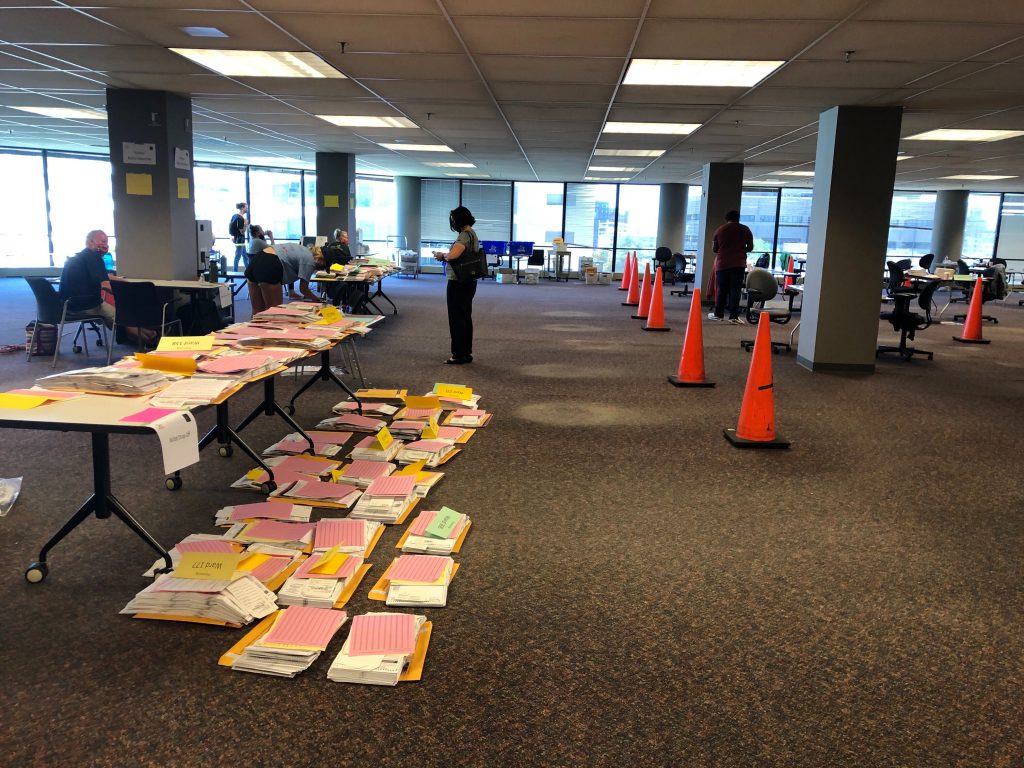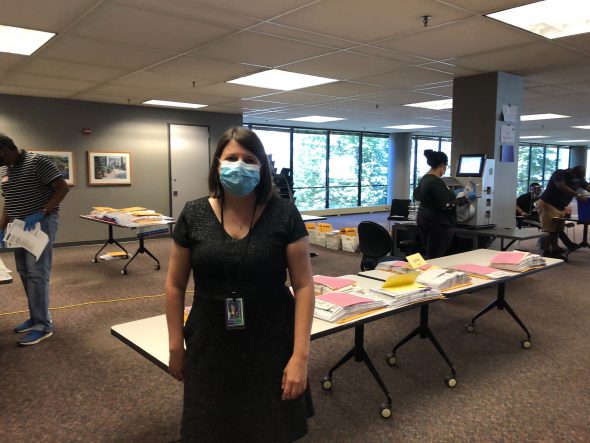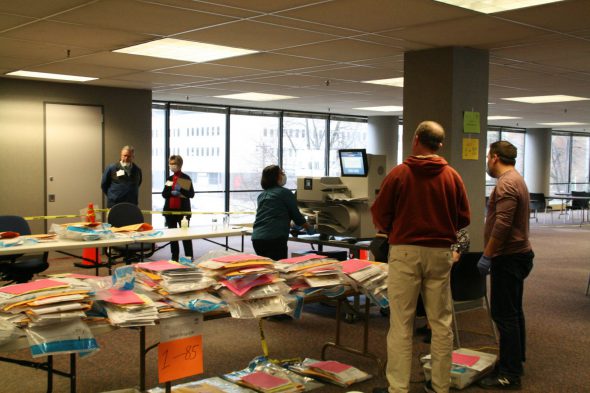When Will Milwaukee’s Presidential Election Results Come In?
The primary had voters waiting until 2:30 a.m. Next race could have three times the ballots.

Ballots sorted by ward during the August 11th election, an election observer looks on. Photo by Jeramey Jannene.
If Tuesday’s partisan primary election was any indicator, Americans will go to bed on election day without knowing who the next President of the United States will be.
Things appeared to be going smoothly, until they weren’t.
The City of Milwaukee Election Commission turned in almost all of its in-person voting results less than two hours after polls closed at 8 p.m. on Tuesday. Modems in the machines at polling sites transmit election results directly to the Milwaukee County Election Commission.
Approximately 19,000 people voted in person, but over 50,000 voted absentee.
Those absentee ballots, similar to other Milwaukee County municipalities, are processed at what’s known as a central count facility. The city normally processes its ballots in a small warehouse in Walker’s Point, but has had to relocate to an entire floor of a downtown office building because of the swelling number of mail ballots and the need for social distancing during the pandemic.
State law allows vote processing to start when polls open at 7:00 a.m., and that’s just what happened Tuesday.
Approximately 200 people, many of whom are current or retired city employees, could be found on the 62,000-square-foot, fourth floor of the 501 W. Michigan St. building sorting, reviewing and processing ballots.
They didn’t finish their work until 2:30 a.m., an effort that Milwaukee Election Commission executive director Claire Woodall-Vogg said was a success given the circumstances.
“We all patted ourselves on the back at 2:30 a.m.,” said the executive director in an interview Wednesday, fresh off having overseen her first election as director.
Still, she originally envisioned being done much earlier.
At 10 a.m. on Tuesday Woodall-Vogg told the media the results would be available shortly after polls close. By 4 p.m. she deemed her prediction “too optimistic” and said she could only estimate the results would come in “tonight.” By that point, a bottleneck was already forming with the four processing machines to process ballots in batches from over 300 wards. But things appeared to be moving steadily.
What happened?
“We saw an unprecedented number of ballots returned between 5 and 8 p.m.,” said Woodall-Vogg. Somewhere between 1,000 to 2,000 ballots arrived at the facility in that window.
They came from a last chance mail collection (one of many that day). State law permits municipalities to accept absentee dropoff at a voter’s polling place, but the city, instead, required those ballots to be delivered to a handful of dropboxes. Because of this policy discrepancy, a number of ballots were accepted under confusion at polling places. This produced exactly what the city was trying to avoid – a delayed coordination effort to make sure all the ballots were where they need to be.
“It’s really just a volume issue,” said Woodall-Vogg.
Why don’t the suburbs that use a central count facility have similar delays? The city has 327 wards, suburbs might have 30 tops. The smaller communities are able to pre-number ballots, eliminating at least one task when the ballots come in. “We can’t do that,” she said, citing scale.
As any freshman year computer science undergrad can attest, sorting gets less efficient with scale. Woodall-Vogg is already looking to address one bottleneck, ballots sorted by ward that pile up on the floor near machines.
The process seems logical, keep the ballots together by ward and store them as close as possible to the processing machines. But as the past two elections have shown, table space is at a premium. Many sorted-ballots end up on the floor, stacked under tables. When new ballots come in, workers are left bending over, sorting through the stacks to find the right ward.
It’s a process ripe for an industrial engineer to overhaul. But that’s precluded now by a lack of money and time. Instead, Woodall-Vogg said, the city will focus on having a better organizing system for November. “We are going to work to improve that process.”
The city will also have more technology. It will have at least 11 machines to process ballots, up from four. Woodall-Vogg is working to secure two more.
But it will also have more ballots. The 50,000 absentee ballots could grow to 150,000. A total of 234,068 Milwaukeeans voted in 2016’s Presidential race.
And despite the delay, Milwaukee made substantial progress on another issue – lines at polling places.
The city had its normal complement of approximately 170 polling places, not the five it had on April 7th early in the pandemic when some voters waited for approximately three hours to vote. The result? The same number of people voted in person, but there wasn’t a line to be found.
What Can You Do to Help?
There are two clear actions one can take to speed up the results and ensure their vote counts.
Two, and more importantly, whatever you do, don’t wait until the last minute. The earlier the city has the ballots the earlier it can be sorted.
“The main delay for us was just processing those ballots that came between 5 and 8,” said Woodall-Vogg. Things will be easier if voters get their ballots in earlier.
If you think stories like this are important, become a member of Urban Milwaukee and help support real, independent journalism. Plus you get some cool added benefits.
More about the 2020 Fall Partisan Primary Election
- When Will Milwaukee’s Presidential Election Results Come In? - Jeramey Jannene - Aug 14th, 2020
- Nine Election Takeaways - Jeramey Jannene - Aug 12th, 2020
- Back in the News: LaTonya Johnson Blasts Lena Taylor - Bruce Murphy - Aug 12th, 2020
- Primary Results Set Stage for November - Shawn Johnson - Aug 12th, 2020
- Jacob Malinowski Wins Democratic Primary for 82nd Assembly District - Jacob Malinowski - Aug 12th, 2020
- Racine Native and National Security Expert Roger Polack Wins Democratic Primary in WI-01 - Roger Polack - Aug 12th, 2020
- Tyrone Cratic Williams Statement of Results of Assembly District 76 Democratic Primary - Tyrone Cratic Williams - Aug 12th, 2020
- Bradley Declares Victory in 28th Senate District Primary - State Sen. Julian Bradley - Aug 11th, 2020
- 2020 Fall Partisan Primary Election Results - Urban Milwaukee - Aug 11th, 2020
- Americans for Prosperity Congratulates Newly Minted Nominees in Their Primary Victories - AFP Wisconsin - Aug 11th, 2020
Read more about 2020 Fall Partisan Primary Election here
More about the 2020 General Election
- Senator Agard Statement on Senator Knodl’s Continued Relitigation of the 2020 Presidential Election - Dane County Executive Melissa Agard - Aug 29th, 2023
- Report Calls For Criminally Charging State’s Fake Electors - Henry Redman - Dec 19th, 2022
- Vos Withdraws Subpoenas, Ends Gableman Probe - Henry Redman - Aug 30th, 2022
- Judge Blasts Gableman Probe, Deleted Records - Henry Redman - Aug 17th, 2022
- Vos Fires Gableman, Ends Election Probe - Shawn Johnson - Aug 14th, 2022
- Judge Orders Gableman To Pay $163,000 In Legal Fees - Rich Kremer - Aug 2nd, 2022
- Prosecute 2020 Fake Electors, Advocates Demand - Erik Gunn - Aug 1st, 2022
- Trump Calls For Nullification of Wisconsin’s 2020 Election - Henry Redman - Jul 12th, 2022
- Legal Fight Over Gableman Probe Keeps Growing - Shawn Johnson - Jun 30th, 2022
- Back In the News: Fake Elector Scheme Dogs Ron Johnson - Bruce Murphy - Jun 28th, 2022
Read more about 2020 General Election here
























Is there any reason Milwaukee does the central count in the first place? Madison does not, and distributes all absentee/early vote ballots to the appropriate wards on Election Day, and they get run through along with the day-of votes.
Madison is usually done by 10-11, despite big turnout and fewer wards. I dont see why this could not be done in MKE.